Key takeaways:
- Choosing a cryptocurrency exchange involves assessing security, fees, and the variety of supported cryptocurrencies.
- Exchanges can be centralized (CEX), decentralized (DEX), or hybrid, each catering to different user needs and levels of control.
- Conducting thorough research on an exchange’s reputation is crucial to avoid issues like poor customer service or funds access problems.
- Fees vary widely among exchanges and can significantly impact trading costs; understanding these structures is essential for informed decision-making.
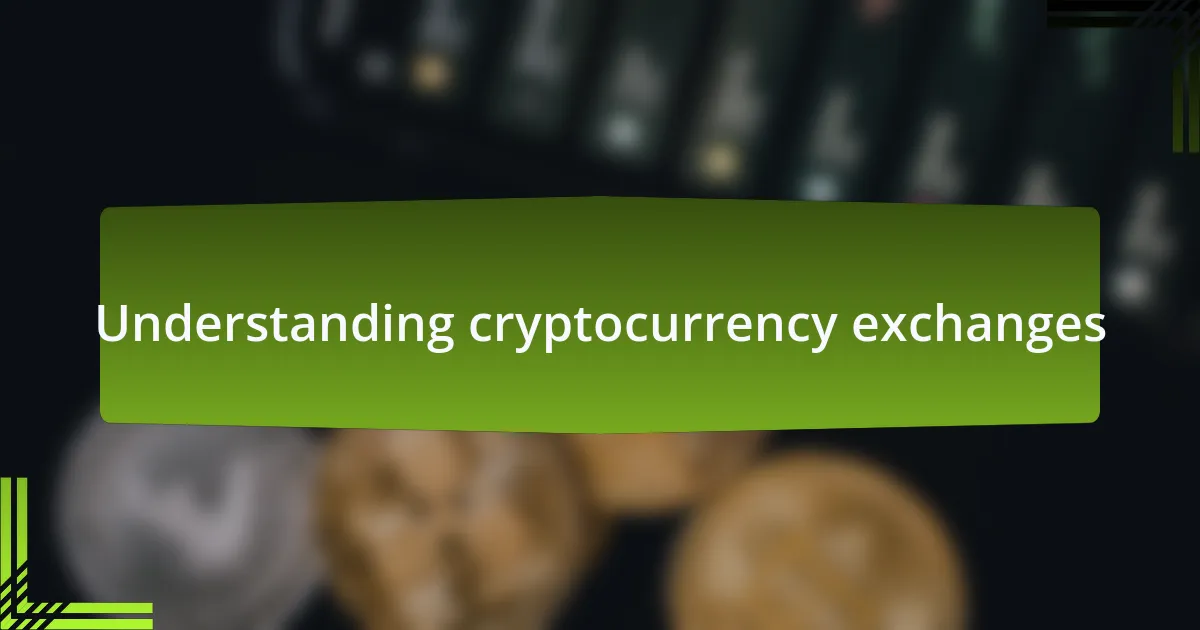
Understanding cryptocurrency exchanges
Cryptocurrency exchanges serve as the bridge between traditional currencies and the digital assets world, allowing users to trade cryptocurrencies like Bitcoin and Ethereum. When I first delved into crypto, I was overwhelmed by the options available. It’s a little like wandering into a vast marketplace where every stall offers something different—some more trustworthy than others.
Choosing the right exchange involves examining a mix of factors, including security, fees, and the variety of currencies supported. I remember my first decision was fueled more by excitement than research; I trusted a platform just because a friend recommended it. This experience taught me a valuable lesson about the importance of due diligence in selecting a secure and reliable exchange.
Have you ever stopped to think about the implications of your exchange choice? It’s more than just a platform for transactions; it reflects your investment strategy and risk tolerance. I learned that particular exchanges cater to different styles, whether you’re a casual trader or a serious investor, which really shaped my own trading journey. Taking the time to evaluate these differences can make a world of difference in your cryptocurrency experience.
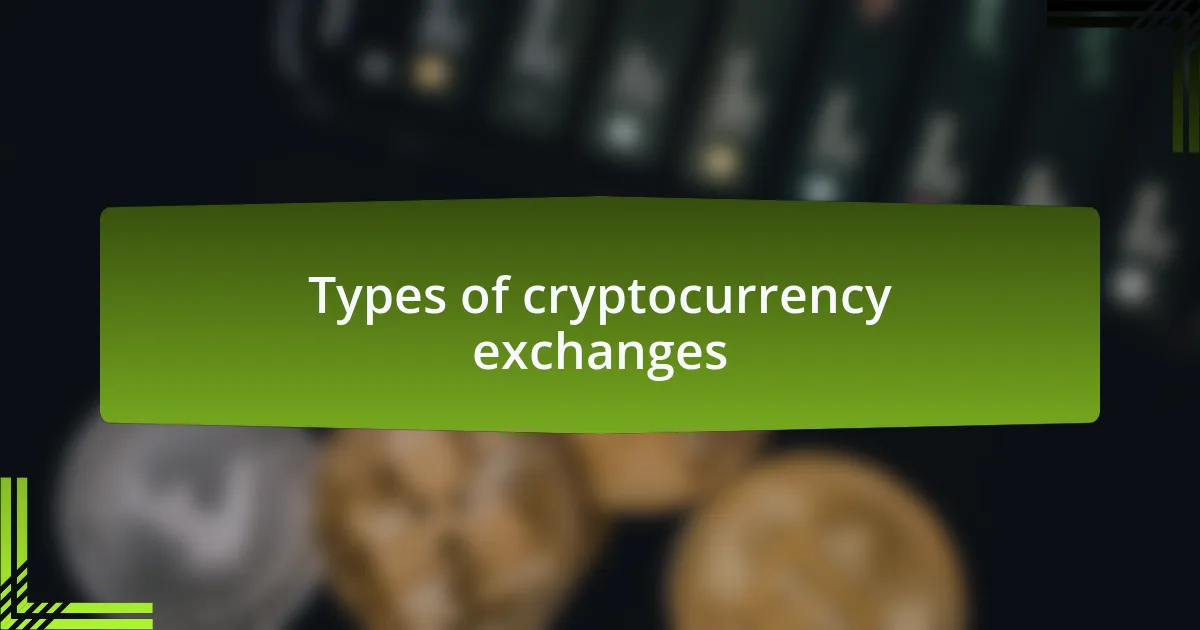
Types of cryptocurrency exchanges
When exploring cryptocurrency exchanges, it’s essential to recognize the primary types available: centralized, decentralized, and hybrid exchanges. Centralized exchanges (CEX) are like your traditional stock exchanges, where a central authority manages transactions, making it user-friendly but often raising concerns about security and control. I’ve used CEX myself, and while the convenience was appealing, it sometimes left me feeling a bit exposed regarding my personal data.
Decentralized exchanges (DEX), on the other hand, operate without a central authority, allowing for peer-to-peer trading. The first time I tried using a DEX, I was both excited and intimidated. The feeling of complete control over my assets was empowering, but without a central support system, I had to navigate the complexities of transactions entirely on my own. It really made me think about how much I valued a trust system in trading.
Then, there are hybrid exchanges that aim to combine the best of both worlds—centralized and decentralized models. I found these particularly intriguing because they strive to offer user-friendly interfaces while maintaining enhanced security. This blend seems to fit my style perfectly, as I prioritize both ease of use and safety. Have you ever wondered how your trading philosophy aligns with these exchange types? I encourage you to reflect on what feels right for you.

Key factors to consider
When choosing a cryptocurrency exchange, security should be at the forefront of your decision-making process. I remember my early days in crypto when I didn’t give it much thought. After hearing stories of hacks and thefts from exchanges, I realized how crucial it is to choose a platform with strong security measures like two-factor authentication and cold storage for funds. How comfortable would you feel trading on an exchange that doesn’t prioritize your safety?
Another key factor to consider is the range of cryptocurrencies offered. In my experience, not all exchanges provide the same selection, which can be a limiting factor. One time, I was eager to trade a lesser-known altcoin but found it wasn’t available on the platform I was using. This restriction made me rethink my options and led me to a new exchange that had a broader array of tokens, which ultimately enhanced my trading experience.
Fees can significantly impact your bottom line, so it’s vital to understand the fee structure before committing to a platform. I once overlooked this detail and was shocked when I saw the withdrawal fees on my first exchange. It felt like a gut punch, and I quickly learned to read the fine print. Have you checked how transaction and withdrawal fees might affect your trading strategy? Understanding these costs upfront can save you not just money but a lot of frustration down the line.

Researching exchange reputations
When I began my journey into cryptocurrency, I quickly learned that understanding an exchange’s reputation is vital. I spent hours scrolling through user reviews and checking out forums to gauge the overall sentiment about the exchanges I was considering. It’s amazing how the community can highlight both strengths and weaknesses that may not be evident at first glance. Have you ever come across a platform that seemed perfect, only to discover it had a history of poor customer service?
Delving into the reputation of an exchange can also illuminate issues such as delays in withdrawals or account freezes. I remember one instance where I almost chose an exchange that had multiple reports of users facing trouble accessing their funds. The thought of being locked out of my money sent chills down my spine. Isn’t it better to feel secure knowing your assets are safe and easily accessible?
One effective strategy I found was to seek out transparent exchanges with a history of strong performance. For instance, after researching one exchange that had been operational for several years without major incidents, I felt much more confident. It proved to me that some platforms earn their reputation over time through consistent service and reliability. What would you prefer – a popular exchange that gets frequent complaints or a less-known one with stellar feedback?
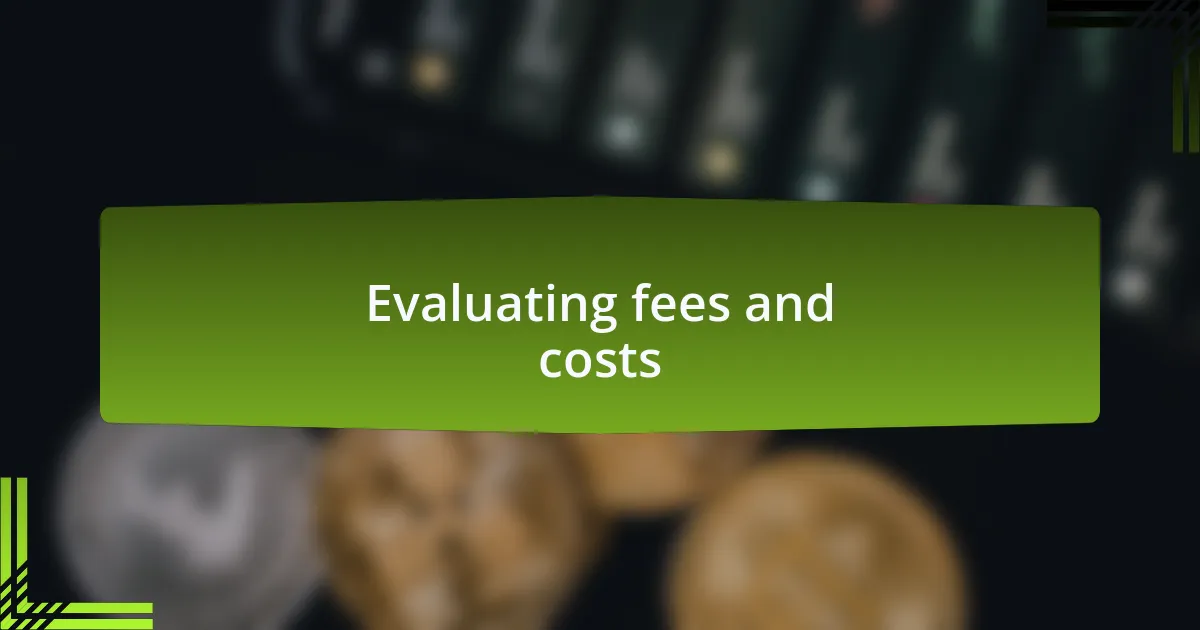
Evaluating fees and costs
Evaluating fees and costs is crucial when choosing a crypto exchange. I found that different platforms have varying fee structures, including trading fees, withdrawal fees, and deposit fees. For instance, I once chose an exchange based on its low trading fees, only to realize later that the withdrawal fees were quite steep, resulting in unexpected costs when I decided to move my funds. Have you ever felt caught off guard by hidden fees?
As I dug deeper into the fee structures of various exchanges, I noticed that some offered tiered pricing based on trading volume. This was a revelation for me because I had plans to actively trade, and understanding how those volumes could reduce my fees was essential. I remember a time when I calculated potential costs before making a move; the difference was significant for someone like me who was still trying to build my portfolio. Isn’t it reassuring to know that by simply switching exchanges or altering trading habits, I could save money?
I also learned to consider the overall cost of trading versus the quality of the platform. While one exchange might entice users with low fees, its less-than-stellar user experience can lead to frustration and lost opportunities. Reflecting on my journey, I’ve realized that while fees matter, I would take a reliable platform with slightly higher costs over a cheaper one riddled with issues any day. Are we not all after that balance between cost and convenience?
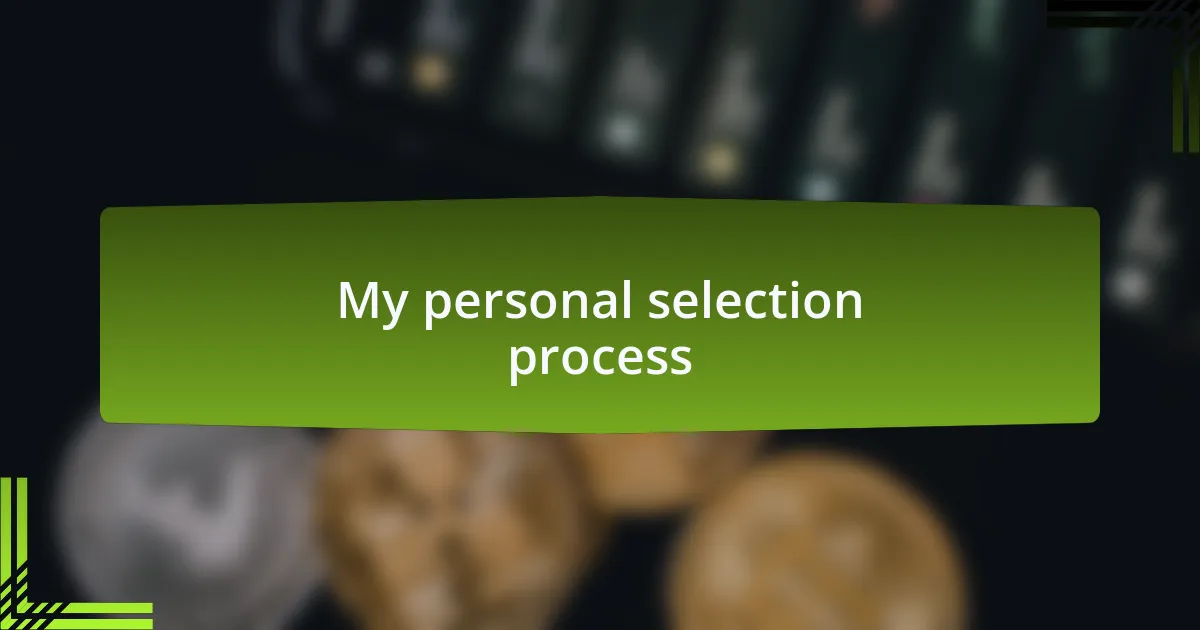
My personal selection process
When it came to selecting my preferred crypto exchange, I prioritized security above everything else. I vividly recall the sinking feeling I had after reading about a prominent exchange being hacked. It made me realize that no amount of low fees could compensate for the potential loss of my assets. Since then, my focus shifted toward platforms that offered robust security measures, like two-factor authentication and cold storage of funds. Isn’t it comforting to know that making security a priority can safeguard your investments?
Next in my selection process was the user experience of the platform. I’ve spent time navigating several exchanges, and I can honestly say that a clean, intuitive interface can make all the difference. I remember my first experience on a platform that felt clunky and confusing; it resulted in more than a few frustrating moments as I tried to complete transactions. It’s almost like online shopping—would you choose a site that’s difficult to navigate, even if it has great deals? The answer for me is a resounding no.
Lastly, I took a good look at the variety of cryptocurrencies available. I’m someone who enjoys exploring different options beyond Bitcoin and Ethereum. I recall feeling elated when I discovered an exchange that offered a diverse range of altcoins. That opened the door for me to diversify my investments and explore new projects. Wouldn’t you feel empowered by having that kind of choice at your fingertips?
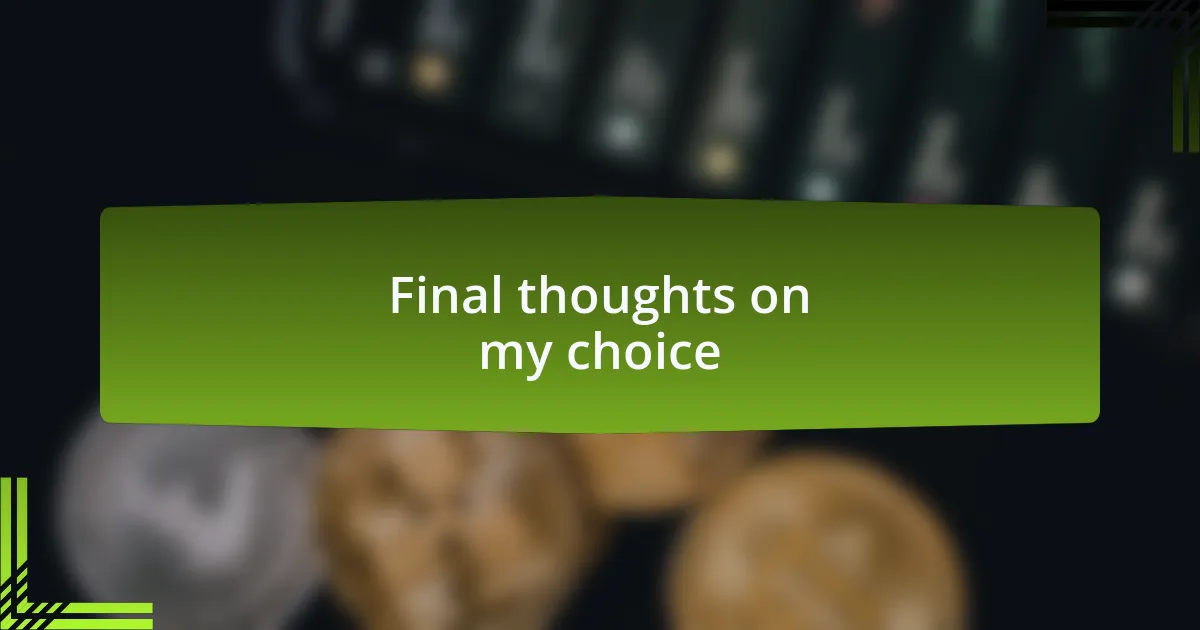
Final thoughts on my choice
Choosing my crypto exchange was more than just a transaction; it felt like selecting a partner in a journey, one that would safeguard my investments. I remember the relief I felt when I finally settled on a platform that not only prioritized security but also had a reputation built on trust. How reassuring is it to know that I can trade with peace of mind, knowing my assets are well-protected?
The ease of use wasn’t just a nice perk; it was essential for me. I think back to the many times I struggled to place orders on those overly complicated interfaces. It was a nightmare. When I found an exchange that offered a seamless experience, it was like a weight lifted off my shoulders. Isn’t it amazing how functionality can transform a sometimes nerve-wracking process into something enjoyable?
Finally, discovering a platform that offered a rich variety of cryptocurrencies felt like opening a treasure chest. Each new option I explored brought excitement and hope for potential growth. I recall the thrill of researching lesser-known coins and believing in their future. Isn’t it empowering to know that the choices I make today could shape my financial future tomorrow?